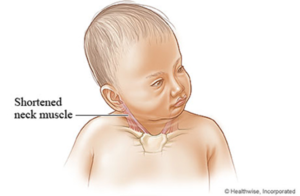
The girl looked directly at me. There was no smile on her lips. Her head was twisted to the left. This is a condition known among medical practitioners as Torticollis.
“Could you please look to your left? Now, to the right?” I tried to move the 7-year-old’s head but failed. Examination performed on her neck showed no signs that she was having pain when the bony parts of her neck were palpated (pressed on). However, her neck muscles were in a state of spasm or cramp.
“Did your daughter fall or experience any trauma to her neck before her head becomes twisted like this?” I need to confirm that this Torticollis is not caused by a fracture or sprain of the neck muscle. “Never.” Answered the father briefly.
“Has she had fever within the past one or two weeks?” I blurted another question. I was considering a rarest, but possible diagnosis – ‘Grisel’s syndrome’.
“Oh, she had, doctor. In fact she just recovered from a fever two weeks ago, she had infection of her tonsils. The doctor in a private clinic gave her an antibiotic, and her fever resolved, but her head becomes twisted like this, doctor.” Her father explained in length.
I diagnosed her with Grisel’s Syndrome. She was admitted to the ward for Halter tractionwhereby her head will be carefully, slowly and equally pulled to enable her twisted head to be positioned back to normal. The girl recovered after a week in the ward.
Torticollis may be caused by multiple factors. Generally, it is divided into two groups, which are Congenital (Torticollis detected since birth) or Acquired (Torticollis caused by other causes).
Congenital Torticollis
- Congenital Muscular Torticollis
It happens in 0.3 to 2 percent of births. The actual cause of Congenital Torticollis remains unknown. Theories suggest birth trauma or position of baby in the womb to be the cause.
Acquired Torticollis (Secondary Torticollis)
- Grisel’s Syndrome (consequence of infection of the ear or throat).
- Injury to the bone or joint of the neck.
- Injury to the neck muscles.
- Tumour of the Sternocleidomastoid muscle.
- Injury to the Sternocleidomastoid nerve.
- Injury to the blood vessels supplying the Sternocleidomastoid muscle.
- Enlargement of lymph nodes in the neck.
- Brain tumour (Posterior Fossa Tumour or base of skull tumour).
- Certain medications such as antipsychotics and phenothiazines.
Usually patients will present with a twisted head towards the affected muscle. Movements of the neck are limited, and if left untreated, could cause neck pain and headache.
Treatment for Torticollis depends on the diagnosis given. Majority of the conditions only require traction and physiotherapy. However, surgery might need to be done if these treatments are not successful. You are advised to immediately consult a doctor if it happens to your family members.
This article is written by one of Malaysian Medical Gazette columnist, Dr Mahyuddin, an Orthopaedic Surgeon who is currently serving in a hospital in Terengganu. Get to know him more in The Team’s page.
References:
- Orthopaedic Secrets, 3rd Edition. David E. Brown, Randall D. Newmann
Cheng, JC; Wong, MW; Tang, SP; Chen, TM; Shum, SL; Wong, EM (2001). “Clinical determinants of the outcome of manual stretching in the treatment of congenital muscular torticollis in infants. A prospective study of eight hundred and twenty-one cases”. The Journal of bone and joint surgery. American volume 83–A (5): 679–87.
This article is translated from Bahasa Malaysia into English by Dr Aini Hanan Azmi.
